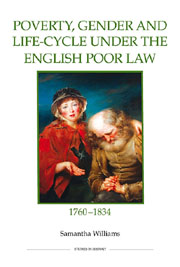Book contents
- Frontmatter
- Contents
- List of figures
- List of tables
- Dedication
- Acknowledgements
- Abbreviations
- Map 1 Bedfordshire, c.1834
- Introduction
- 1 People, place and poverty
- 2 Policy and paupers
- 3 Paying for poverty
- 4 Gender, life-cycle and the life-course
- 5 Work, unemployment and the makeshift economy
- Conclusion
- Bibliography
- Index
5 - Work, unemployment and the makeshift economy
Published online by Cambridge University Press: 05 February 2013
- Frontmatter
- Contents
- List of figures
- List of tables
- Dedication
- Acknowledgements
- Abbreviations
- Map 1 Bedfordshire, c.1834
- Introduction
- 1 People, place and poverty
- 2 Policy and paupers
- 3 Paying for poverty
- 4 Gender, life-cycle and the life-course
- 5 Work, unemployment and the makeshift economy
- Conclusion
- Bibliography
- Index
Summary
That the poor law played a central part in local labour markets, as well as in the household economies of the labouring poor, is widely acknowledged. Crucial issues were the relief of unemployment, the setting of the poor to work, and the nature of the makeshift economy. There was widespread seasonal un- and under-employment of men and boys in agriculture in the cereal-growing regions after 1813; evidence for this in Campton and Shefford is to be found in the ‘masculinisation’ of the relief rolls. while most unemployed adult men and boys received only occasional payments in cash and kind, elderly men were increasingly reliant on regular poor relief as overseers sought to alleviate the surplus labour problem by siphoning off this group of working, but increasingly infirm, men. The post-war period was characterised by a proliferation of make-work schemes for the unemployed, while the parish also employed local people in a wide range of other parish tasks. After earnings, poor relief provided the core of the wider ‘economy of makeshifts’ by which the poor put together a living, but the makeshift economy also encompassed a diverse range of other resources and self-provisioning activities.
Unemployment and make-work schemes
widespread winter unemployment in rural agricultural parishes has been dated to the period after 1813. One of the worst years was 1816 since the unemployment problem was aggravated by the discharge of troops. There was a temporary recovery in 1817 and 1818, but thereafter under- and unemployment increased again until the 1830s. In the words of Alan Armstrong, ‘the distress seemed all but incurable’. Norman Gash has estimated that men were on parish allowances for three to five months of the year at below Speenhamland standard rates.
- Type
- Chapter
- Information
- Publisher: Boydell & BrewerPrint publication year: 2011

